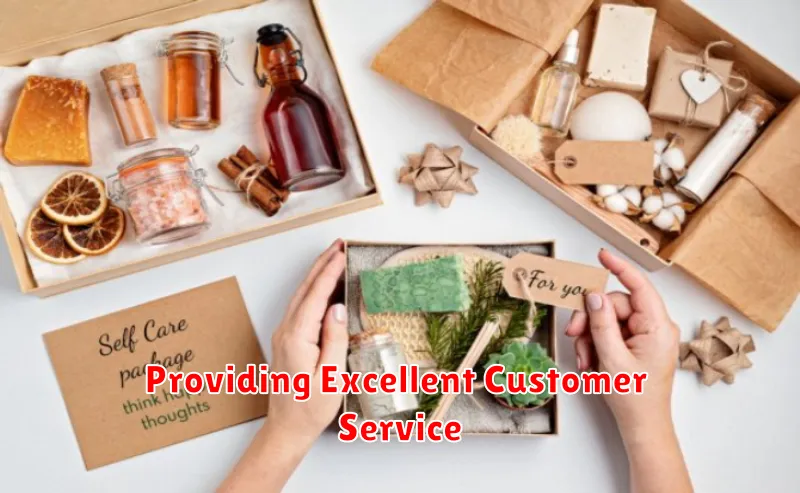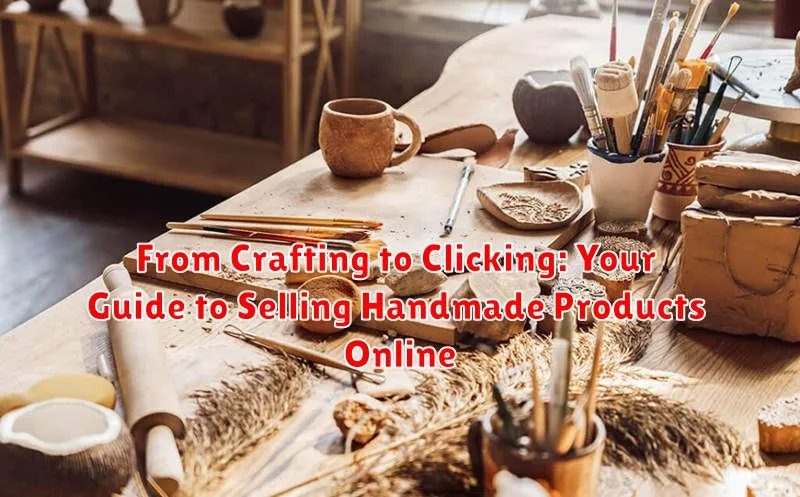Are you a passionate artisan looking to expand your reach and sell your handmade products online? The digital marketplace offers incredible potential for craftspeople to connect with a global audience and build a thriving business. This guide will provide you with a comprehensive overview of how to transition from crafting in your workshop to clicking your way to online sales success. We will explore the essential steps involved in establishing your online presence, marketing your unique creations, and managing the practicalities of selling handmade goods in the digital sphere. Whether you’re a seasoned crafter or just beginning your entrepreneurial journey, this guide is designed to empower you with the knowledge and resources necessary to thrive in the world of online handmade product sales.
From setting up your online shop and crafting compelling product descriptions to navigating shipping logistics and building a loyal customer base, we’ll cover all the key aspects of selling your crafts online. Learn how to leverage the power of social media marketing, optimize your product listings for search engines, and create a brand that resonates with your target audience. Discover the tools and platforms that will streamline your operations and allow you to focus on what you do best: creating beautiful, handmade products. This comprehensive guide will equip you to successfully navigate the exciting world of online handmade sales and transform your passion into a profitable business.
Identifying Your Niche and Target Audience
Before launching your online handmade business, it’s crucial to identify your niche and target audience. This focused approach will help you tailor your products, marketing, and branding for maximum impact.
Defining your niche involves specializing in a specific area within the broader handmade market. Instead of offering a wide variety of crafts, consider focusing on a particular type of product or a specific style. This allows you to develop expertise and cater to a specific customer base. For example, instead of simply selling “jewelry,” you might specialize in “minimalist silver earrings” or “upcycled vintage brooches.”
Identifying your target audience is equally important. Ask yourself: Who is most likely to buy my products? Consider demographics like age, gender, location, interests, and lifestyle. Understanding your ideal customer allows you to create targeted marketing campaigns and connect with them on a personal level. Knowing your audience informs your decisions about everything from product development to pricing.
Creating High-Quality Product Photos that Sell
High-quality product photography is crucial for attracting customers and driving sales in the online marketplace. Your photos are the first impression potential buyers have of your handmade creations, so they must accurately represent the quality and craftsmanship of your work.
Lighting plays a vital role. Natural light is generally preferred, as it showcases the true colors and textures of your products. Avoid harsh shadows by diffusing the light or shooting on a slightly overcast day. If using artificial light, invest in a lightbox or softbox for even illumination.
A clean and uncluttered background is essential. A simple white or neutral backdrop allows your products to stand out and minimizes distractions. Consider using a sweep or a piece of seamless paper for a professional look.
Showcase your products from multiple angles. Include close-up shots to highlight intricate details and textures. Consider lifestyle shots to demonstrate how the product can be used or worn, giving customers a better sense of its scale and functionality.
Editing your photos is a key step. Adjust brightness, contrast, and sharpness to optimize image quality. However, avoid over-editing, as this can misrepresent the actual product. Consistency in editing across all your product photos is essential for a cohesive brand image.
Setting Up Your Online Store: Platform Options
Choosing the right platform is crucial for your online success. Consider your budget, technical skills, and the level of customization you require. Here’s a breakdown of popular options:
E-commerce Platforms
Etsy: Ideal for beginners, Etsy is specifically designed for handmade and vintage items. It boasts a large built-in audience and offers easy setup. However, transaction fees and limited customization options are factors to consider.
Shopify: This platform provides more control over your store’s design and functionality. It offers a wider range of tools for marketing and growth, but comes with a monthly subscription fee.
Squarespace: A user-friendly option known for its visually appealing templates. Squarespace is suitable for those prioritizing aesthetics and simplicity, although its e-commerce features may be less robust than dedicated platforms like Shopify.
Other Options
Your Own Website: Provides maximum control and branding potential. Requires technical expertise or hiring a developer. Consider platforms like WordPress with WooCommerce for enhanced e-commerce features.
Social Media Platforms: Platforms like Instagram and Facebook offer shopping features, allowing you to sell directly to your followers. These can be good supplementary sales channels, particularly for reaching an already engaged audience.
Crafting Compelling Product Descriptions
Your product descriptions are your online sales pitch. They bridge the gap between seeing your beautiful handmade creation and clicking “add to cart.” Clarity and compelling language are crucial. Don’t just list features; tell a story.
Highlight the unique qualities of your handmade items. What materials did you use? What techniques did you employ? Was it inspired by something specific? These details add value and appeal to buyers seeking one-of-a-kind products.
Focus on benefits. How will this product improve the customer’s life? Will it make them feel more confident, organized, or joyful? Connect your product to their needs and desires.
Use sensory language to bring your product to life. Describe the texture, the scent, the way it feels in their hands. If applicable, suggest usage scenarios to help customers envision themselves enjoying your product.
Pricing Strategies for Handmade Goods
Pricing your handmade products strategically is crucial for success. Cost-plus pricing is a fundamental method. Calculate all costs involved in creating your product (materials, labor, overhead) and add a markup percentage for profit. This ensures you cover expenses and earn a reasonable return.
Value-based pricing considers the perceived value of your product to the customer. Factors like unique design, high-quality materials, and brand reputation can justify higher prices. Research competitor pricing to understand the market landscape and position your products accordingly. Don’t undervalue your craftsmanship!
Competitive pricing involves setting prices similar to your competitors. This strategy can be effective if your products offer comparable quality and features. However, it can lead to price wars and reduced profit margins. Consider offering bundled deals or tiered pricing for variations in size or customization to differentiate yourself.
Marketing and Promoting Your Handmade Business

Effectively marketing your handmade products is crucial for online success. Understanding your target audience is the first step. Who are they? What are their interests? Where do they spend their time online?
Once you know your audience, you can tailor your marketing efforts. Craft compelling product descriptions that highlight the unique qualities of your handmade items. Showcase the craftsmanship and materials used.
High-quality product photography is essential. Clear, well-lit images that capture the detail and beauty of your work will attract potential customers. Consider using different angles and lifestyle shots to showcase your products in use.
Pricing your products competitively is also important. Research similar items on the market to determine a fair price that reflects the value of your work and materials while remaining competitive. Factor in your time and labor.
Building a Strong Social Media Presence
Social media is a powerful tool for connecting with potential customers and showcasing your handmade products. Consistency is key. Regularly post engaging content that highlights the quality and uniqueness of your creations.
Choose the right platforms. Where does your target audience spend their time? Focus your efforts on those platforms. Instagram and Pinterest are visually driven and ideal for showcasing handcrafted items. Facebook can be effective for building community and running targeted ads. Consider Etsy’s built-in marketplace features as well.
High-quality photography is essential. Invest in good lighting and learn basic styling techniques to present your products in the best possible light. Compelling captions should accompany your visuals, telling a story, highlighting features, and encouraging engagement.
Interact with your followers. Respond to comments and messages promptly and participate in relevant online communities. Consider running contests or giveaways to increase visibility and generate excitement around your brand.
Managing Orders and Shipping Logistics
Efficient order management and shipping are crucial for customer satisfaction and the success of your handmade business. Organization is key. Implement a system for tracking orders from receipt to shipment. This could be a simple spreadsheet, dedicated software, or an integrated platform.
Packaging your products securely and attractively is important. Use appropriate materials to prevent damage during transit. Consider branded packaging for a professional touch. Calculate shipping costs accurately. Offer various shipping options to cater to customer preferences and budgets. Clearly communicate shipping times and costs on your website.
Shipping labels should be clear, accurate, and legible. Consider using a thermal printer for efficient label creation. Partner with a reliable shipping carrier that offers tracking and insurance. Provide customers with tracking information so they can monitor their order’s progress. Maintain accurate records of all shipments for accounting and customer service purposes.
Providing Excellent Customer Service

Exceptional customer service is crucial for the success of any online business, especially when selling handmade products. A positive customer experience fosters loyalty and encourages repeat business, as well as positive word-of-mouth referrals.
Communication is key. Respond to customer inquiries promptly and professionally. Be proactive in providing updates on order status and shipping information. A personal touch, such as a handwritten thank you note, can go a long way in building rapport.
Address issues effectively. Mistakes can happen. How you handle them determines customer satisfaction. Be understanding and empathetic when a customer expresses a concern. Offer solutions, such as replacements or refunds, to resolve problems quickly and fairly.
Solicit feedback. Encourage customers to leave reviews and provide feedback. This valuable information can help you improve your products and services. Actively engage with reviews, responding to both positive and negative comments.

